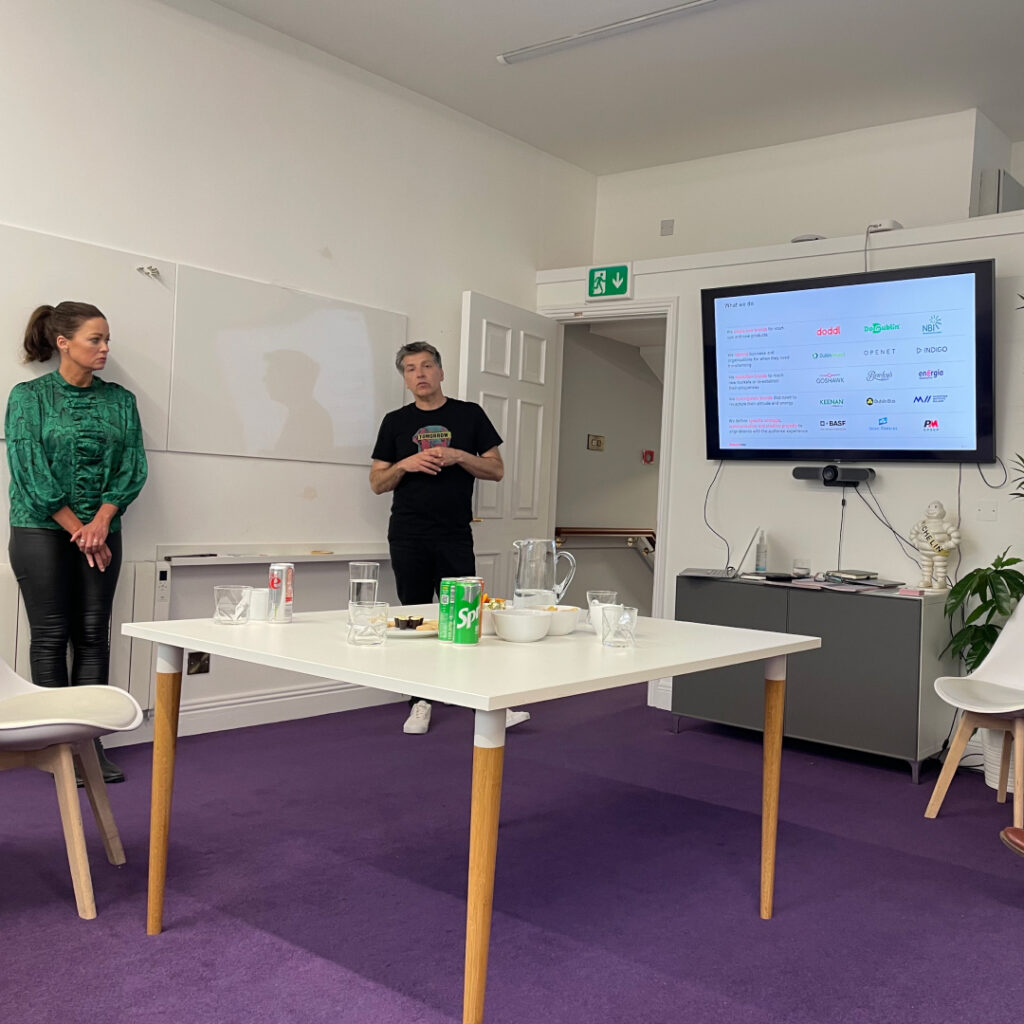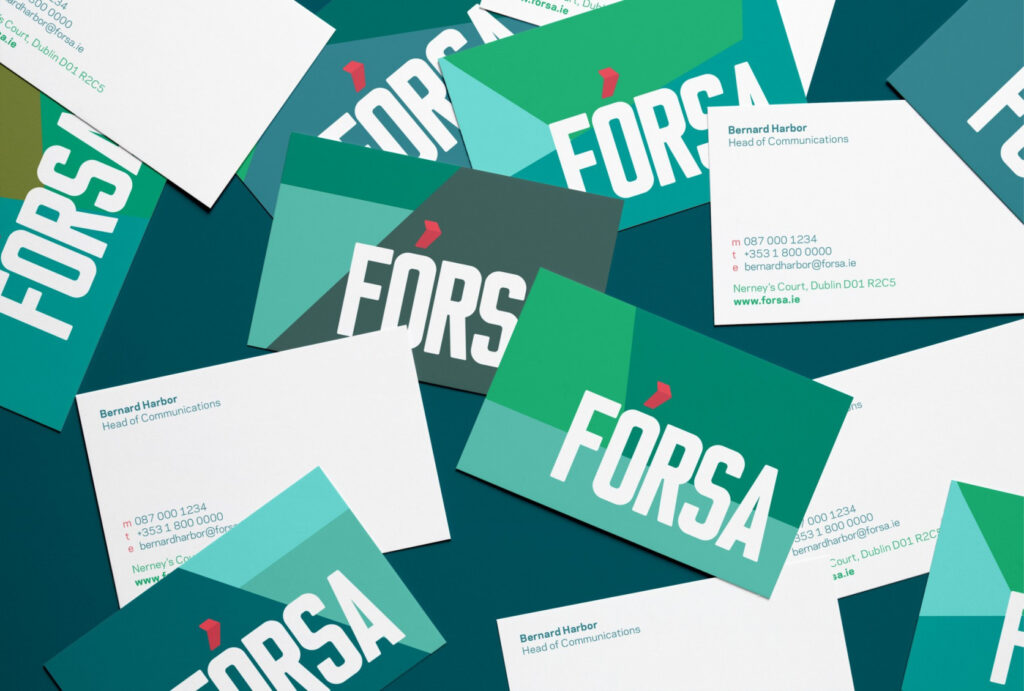Mai lõpus külastas grupp eesti disainereid Iirima pealinna Dublint, kus külastati kohalikke disainibüroosid, visuaalkultuurile ning disainile keskendunud haridusasutusi.
Dublin (Baile Átha Cliath in Irish) on Iirimaa pealinn, mis paikneb oma peamiste aladega Liffey jõe suudmes. Linn loodui 840 viikingite poole ning hetkel elab seal veidi poole miljoni inimese. Liffey jõgi on linna tõeline sümbol ning jõe ümbrusesse on koondunud ka kogu linna aktiivsem elu. Linna nimi tuleb väljendist Dubh City (dubh → must / dtume and city → body of water). Algupärane nimi tuleneb kelti keelest, kuid seda muudeti peale prantsuse keelt kõnelevate normannide sissetungi, kui linna nimi muudeti Develyniks, millest omakorda tuletati Dublin. Lisaks on veel müüte, et Dublin tuleb islandi keelesest sõnast djúp bird mis tähendab sügavat loiku.
Iirima on alati tahtnud olla iseseisev, kuid nagu ka Eesti, on ka nende mõjutused tingitud ümber asuvatest suurtest naabritest. Ajalugu on näinud ka mitmeid sõdu, mille mõjusid kohati nende kultuuris või ka arhitektuuris tänaseni kohata võib. Kuni II maailmasõjani oli Dublin nn halb osariik, kogu linna hiilgus oli kadunud, tänavad olid tühjad, räpased ning kogu linnaruum lagunenud. Suured investeeringud linna algasid alles 1997. aastal, mil otsustati kohalike ning erainvestoritega ehitada linna taas üles.
Dublin on maailmas kuulus kirjanduse linnana. See on koduks mitmele tuntud Nobeli preemia võitjale ning kuulsatele kirjanikele William Butler Yeats ja Oscar Wilde.
Dublini ning iirlaste vahel on sarnasusi päris mitmeid. Ajalooliselt, nagu juba märgitud eelnevalt, on võideldud Dublini nimel mitmeid sõdu ning omad mõjutused on olnud ka oma suurel naabril, keda ükski riik endale valida ei saa.
Iirimaa on olnud Inglisemaa all pikki aastaid mistõttu nad ei saa endale lubada suurt majanduslikku arengut. Neil puudub suur tööstuse osa, mis tagaks pideva riikliku ekspordivoolu, mistõttu on Iirimaa keskendunud peamiselt teenuste arendmisele. Üheks suureks müügiartikliks on kindlasti Guiness, mille kreemist maitset on ilmselt proovinud iga õllesõber. Õlle tootmine on üldse Iirimaal vägagi populaarne ning nagu Europa trend hetkel näitab, on ka Iirimaal tekkinud viimaste aastatega mitmeid väikepruulikodasid.
Toetav majanduslik keskkond ning maksupoliitika on andnud samtui Iiri majandusele suure tõuke, kuna mitmed globaalsed ettevõtted (Facebook, Google, Microsoft jt) on loound oma Euroopa keskused just IIrimaale. Nende panus Iiri majanduse arengusse ning tööhõivele on suur, kuid samal ajal tekitab ka ebavõrdseid tingimusi mitmete kohalike äridega kuna kohalikud talendid ostetakse kiiresti suurte hiidude poolt.
Red Dog on iirimaal tegutsenud ligi 30 aastat ning selle ajaga omandanud silmapaistva tööde nimekirja, mis peegeldab kenasti kohalikku ettevõtlust ka koostööd suurde brändidega kes Iirimaal tegutsevad.
Nende tööd on Euroopalikud, rõhuvad lihtsusele ning toimivusele, nagu nad ise ka ütlevad – visaal aitab klientidel äriga tegeleda.


Mitmekülgne digiagentuur, kelle auhindade hulgast leiab nii CSS Design Awards, The Webby Awards, FWA, AWWWARDS ja mitmetelt teistelt konkursitelt. Wondr tundub väike, kuid nende Dublini peakontor ei näita täit potentsiaali ettevõtte võimekuse või rahvusvahelise haarde kohta. Neid on nimetatud kümne maailma kõige võimekama digiagentuuri hulka maailmas.
Simon Richards ja Celine Dee poolt asutatud büroo omab Dublini südalinnas õdusat stuudiokontorit, mis ulatub läbi nelja korruse.
Nende laual on samuti mitmeid nominatsioone ja auhindu, mis kirjeldavad nende kvaliteeti ja mõtlemisoskust. Lisaks on neil alati käimas mitmeid isiklikke sotsiaalprojekte, nt Creatives Against Covid 19, mis Covidi ajal aitas loovinimeste abiga koguda raha Covidiga võitlemiseks.


NCAD (National College of Art and Design) seisab Iirimaal suure ning laia valdkondade arendamise eest. Lisaks päevakajalistele õppekavadele digitaalses disainis, tootearendus või mood hoiavad nad elus ning arendavad nad klassikalisi erialasid nagu klaasipuhumine, metallitöö jms.
Kool toetab palju ka erialade lõimumist ning tudengite koostööd üldiselt. Vormilt on kool segu industriaalkoolist ja ülikoolist ning oma asukohalt mõjub kui loomekesksus, mis paikneb Dublini linna südames.
Kuigi Dolmen defineerib end kui disainistuudio, siis nad on peamiselt fokusseerinud end inseneritööle. Loomulikult on nende töö suur osa visuaalil ja disainil laiemalt, kuid nagu nad ise ka ütlevad, siis nende töid väljendab disaini ja tehnoloogia koostoime. Nende kõige suuremaks ning mainekamaks kliendiks on Guiness, kellele nad on teinud mitmeid nii baaridele kui eratarbijale mõeldud
Lisaks on neil suur hulk kliente meditsiinivaldkonnas, mis oli kohati sarnane kõikide Dublinis külastatud büroode juures.


Teine õppeasutus mida külastasime kandis nime IADT (Institute of Art Design + Technology). Nagu ka NCAD, pakuvad ka disainiharidust, kuid nende peamine fookus on graafilisel disainil, liikuval graafikal ning filmitootmisel üldiselt.










Kasutatud pildimaterjal:
Red Dog, Dolmen, Richards Dee, IADT, NCAD, WONDR, 100 Archive Ireland ja erakogu.